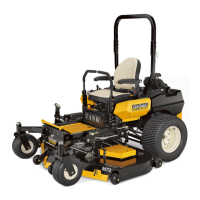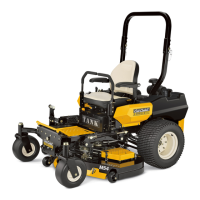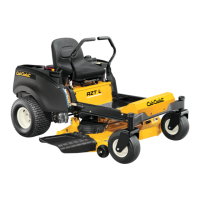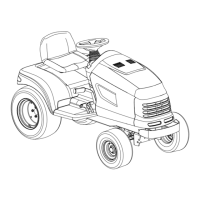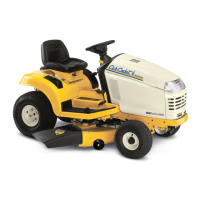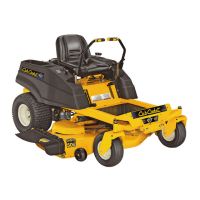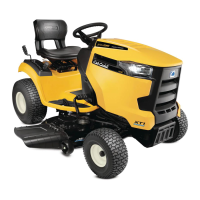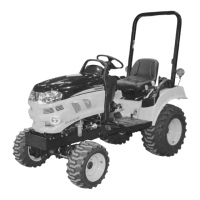Section 6— Maintenance & adjuStMentS30
Battery Storage
1. When storing the tractor for extended periods, disconnect the
negative battery cable. It is not necessary to remove the battery.
2. All batteries discharge during storage. Keep the exterior
of the battery clean, especially the top. A dirty battery will
discharge more rapidly.
3. The battery must be stored with a full charge. A discharged
battery can freeze sooner than a charged battery. A fully
charged battery will store longer in cold temperatures than hot.
4. Recharge the battery before returning to service. Although
the tractor may start, the engine charging system may not
fully recharge the battery.
Tires
Check the tire air pressure before each use. Inflation pressure
of the rear tires is important for stability while the mower is in
operation. If the tire diameter is not equal between the two tires,
the mower will pull to one side. Keep the tires inflated to the
recommended pressures. Improper inflation will shorten the tire
service life. See the tire side wall for proper inflation pressures.
Observe the following guidelines:
• Do not inflate a tire above the maximum pressure shown
on the sidewall of the tire.
• Do not reinflate a tire that has been run flat or seriously
under inflated. Have a qualified tire mechanic inspect and
service the tire.
• Balance inflation pressure between the rear tires to help
maintain straight travel (see tire side wall for proper
inflation pressure).
• Keep the valve caps tightened to prevent air pressure loss.
Inflation Pressure
Rear Tires — 10-12 psi max
Front Tires — 20-25 psi max
Leaking Tires
When a flat tire occurs, repair or replace immediately. The normal
procedure is to remove the wheel and replace it. If a tire is
getting soft, park the mower on the nearest level, paved area.
1. Rear Tire
a. Put blocks on each side of the opposite traction
wheel and jack up the tire that leaks about an inch
off the ground.
b. Loosen and remove the lug nuts and remove the wheel.
c. Mount a wheel and tire, replace the lug nuts, and
using a torque wrench, tighten them to 44-50 ft-lbs.
2. Front Tire
a. Set the park brake and block both rear tires and raise
the front tire so that it is an inch off the ground.
b. Loosen the flange lock nut and remove the spacer,
hex screw and two flat washers from the yoke. The
wheel will drop free.
c. Slip the hex screw, spacer and one flat washer
through one side of the yoke, then through the
wheel to the other side of the yoke.
d. Place a flat washer and a flange lock nut on the hex
screw and tighten to 44-50 ft-lbs to secure the wheel.
e. Lower the mower off the jack and continue mowing.
The wheel with the leaking tire should be inflated to 10-12 psi for
the rear tire and 20-25 psi for the front tire . Then place the wheel in
a large bucket of water. Carefully inspect the tire, rim and valve for
escaping air bubbles which indicate a leak. Mark each leak with a
yellow marking crayon and then deflate the tire to 8 psi and repeat
the inspection. If the leaks you find are pin hole size to ⁄” diameter,
the tire can be repaired. If the leaks are larger than ⁄” diameter, the
tire cannot be repaired. If the tire bead is damaged, the tire can be
repaired or the tire will have to be replaced.
Lubrication
Using a pressure lubricating gun, lubricate all grease fittings and
points as noted in the Lubrication Chart.
Lubricate all other pivot points with a quality lubricating oil as
noted in the Oil Chart.
Spindle Pulleys
Once a month remove the belt covers to remove any accumulation
of grass clippings from around the spindle pulleys and V-belt.
Clean more often when mowing tall, dry grass.
Pump Control
Blow out or clean out the pump control area under the floor pan.
Tractor Storage
If your tractor is not going to be operated for an extended period
of time (thirty days to approximately six months), the tractor should
be prepared for storage. Store the tractor in a dry and protected
location. If stored outside, cover the tractor (including the tires) to
protect it from the elements. The procedures outlined below should
be performed whenever the tractor is placed in storage.
1. Change the engine oil and filter following the instructions
provided in the engine manual.
WARNING! Never store the tractor with fuel in the
tank indoors or in poorly ventilated enclosures, where
fuel fumes may reach an open flame, spark or pilot
light as on a furnace, water heater, clothes dryer, etc.
2. Service the engine as instructed in the separate engine
manual.
3. Engines stored between 30 and 90 days need to be treated
with a gasoline stabilizer such as STA-BIL® and engines stored
over 90 days need to be drained of fuel to prevent deterioration
and gum from forming in fuel system or on essential carburetor
parts. If the gasoline in your engine deteriorates during storage,
you may need to have the carburetor, and other fuel system
components, serviced or replaced.
WARNING! Fuel left in the fuel tank deteriorates
and will cause serious starting problems.
4. Remove the spark plugs and pour approximately one
ounce of oil into each cylinder. Crank the engine one or
two turns to spread the oil evenly on the cylinder walls.
Replace the spark plugs.
4. Clean the engine and the entire tractor thoroughly.
NOTE: Use of a pressure washer or garden hose is not
recommended to clean your tractor. This may cause
damage to electrical components, spindles, pulleys,
bearings or the engine. The use of water will result in
shortened life and reduce serviceability.
5. Sharpen the blades so that the mower will be ready to use
when needed.
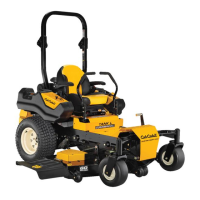
